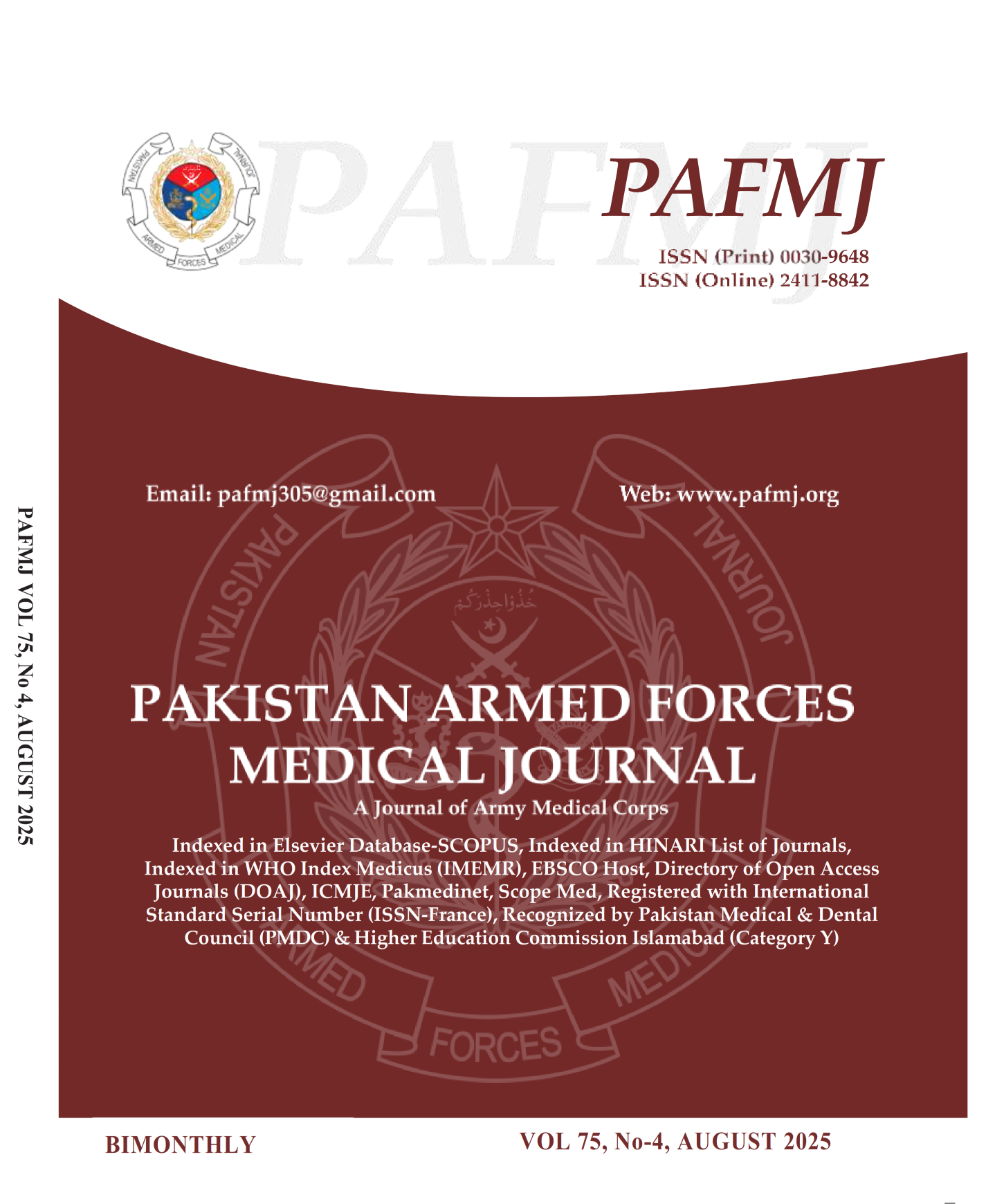Evaluating the Effectiveness of Divergent Versus Crossed Kirschner Wire Techniques in Managing Pediatric Misaligned Fractures Above the Elbow (Supracondylar) in the Humerus
DOI:
https://doi.org/10.51253/pafmj.v75i4.12076Keywords:
Crossed fixation, Kirschner wire, Lateral fixation, Paediatric orthopaedics, Supracondylar humerus fracturesAbstract
Objectives: To compare the effectiveness of lateral and crossed K-wire techniques in treating misaligned supracondylar humerus fractures in children, focusing on functional outcomes and complications.
Study Design: Quasi-experimental study.
Place and Duration of Study: Combined Military Hospital (CMH), Peshawar, Pakistan, from Dec 2019 to Mar 2024.
Methodology: We randomized the participants into Group A, using lateral K-wire fixation (n=58) and Group B, using crossed K-wire fixation (n=65), to compare the efficacy of the two fixation techniques in managing Type III fractures, with outcomes evaluated based on Flynn's Criteria, carrying angle, Baumann's Angle, and time to radiological union. All data was collected systematically and analysed using SPSS version 23.0 to ensure robust statistical evaluation and integrity of the results.
Results: Loss of carrying angle showed no statistically significant difference between the groups while mean loss of Baumann Angle was highest in Group B (3.99±1.01) as compared to Group A (2.48±1.73) with statistically significant difference (p-value < 0.001).
Conclusion: Both lateral and crossed K-wire techniques effectively treat displaced supracondylar humerus fractures in children, showing similar outcomes and low complication rates.
Downloads
References
1. Vaquero-Picado A, González-Morán G, Moraleda L. Management of supracondylar fractures of the humerus in children. EFORT Open Rev. 2018; 3(10): 526–540. https://doi.org/10.1302/2058-5241.3.170049
2. Saeed W, Waseem M. Elbow fractures overview. StatPearls. Treasure Island: StatPearls Publishing; 2024.
3. Kropelnicki A, Ali AM, Popat R, Sarraf KM. Paediatric supracondylar humerus fractures. Br J Hosp Med. 2019; 80(6): 312–316.
https://doi.org/10.12968/hmed.2019.80.6.312
4. Palange ND, Kumar GS, Mane AA, Pawar E. A comparison between percutaneous cross K-wire and lateral K-wires fixation in management of Type III Gartland paediatric supracondylar fractures. Int J Orthop. 2019; 5(2.2): 119–122.
https://doi.org/10.22271/ortho.2019.v5.i2c.22
5. Duffy S, Flannery O, Gelfer Y, Monsell F. Overview of the contemporary management of supracondylar humeral fractures in children. Eur J Orthop Surg Traumatol. 2021; 31(5): 871–881. https://doi.org/10.1007/s00590-021-02932-2
6. Durusoy S, Öner K, Özer A, Sevinç HF. The effect of the angle between fracture line and Kirschner wires on stability in supracondylar humerus fractures treated with Kirschner wire fixation: A finite element analysis. Jt Dis Relat Surg. 2021; 32(1): 75–84. https://doi.org/10.5606/ehc.2021.77279
7. Ma HL, Sun XW, Liu F, Hua ZT, Sun J, Zhang SC. Kirschner wire reconstruction of medial and lateral column periosteal hinge in the treatment of multidirectionally unstable supracondylar fracture of the humerus in children. Eur J Med Res. 2023; 28(1): 585.
https://doi.org/10.1186/s40001-023-01560-2
8. Woo CY, Ho HL, Ashik MBZ, Lim KB. Paediatric supracondylar humeral fractures: a technique for safe medial pin passage with zero incidence of iatrogenic ulnar nerve injury. Singapore Med J. 2018; 59(2): 94–97.
https://doi.org/10.11622/smedj.2017094
9. Kumar M, Lakhey RB, Shrestha BL. Radiographic measurement of lateral capitellohumeral angle and Baumann’s angle among children. J Nepal Health Res Counc. 2022; 20(2): 296–300. https://doi.org/10.33314/jnhrc.v20i02.3825
10. Ahmad Khan RD, Yousaf MN, Zain-Ur-Rehman M, Fareed MI, Yasin A. Outcome of open reduction internal fixation with cross K-wires for supracondylar fracture of humerus in terms of Flynn's criteria in children. J Pak Med Assoc. 2015 Nov;65(11 Suppl 3) : S186–S189.
11. Joshi T, Koder A, Herman MJ. Staying out of trouble: complications of supracondylar humerus fractures. Instr Course Lect. 2019; 68: 357–366.
12. Prusick VW, Gibian JT, Ross KE, Moore-Lotridge SN, Rees AB, Mencio GA, Stutz CM, Schoenecker JG. Surgical technique: closed reduction and percutaneous pinning of posterolaterally displaced supracondylar humerus fractures. J Orthop Trauma. 2021 Mar 1; 35(3): e108–e115.
https://doi.org/10.1097/BOT.0000000000001854
13. Rees AB, Schultz JD, Wollenman LC, Moore-Lotridge SN, Martus JE, Mencio GA, Schoenecker JG. Internal rotation stress test reduces cross-pinning and improves outcomes in displaced pediatric supracondylar humeral fractures. JB JS Open Access. 2021; 6(3): e21.00014.
https://doi.org/10.2106/JBJS.OA.21.00014
14. Graff C, Dounas GD, Sung J, Kumawat M, Huang Y, Todd M. Management of iatrogenic ulnar nerve palsies after cross-pinning of pediatric supracondylar humerus fractures: a systematic review. J Child Orthop. 2022; 16(5): 366–373.
https://doi.org/10.1177/18632521221124632
15. Naik LG, Sharma GM, Badgire KS, Qureshi F, Waghchoure C, Jain V. Cross pinning versus lateral pinning in the management of Type III supracondylar humerus fractures in children. J Clin Diagn Res. 2017; 11(8) : RC01–RC03.
https://doi.org/10.7860/JCDR/2017/28481.10351
16. Patil S, Gaonkar N, Pandey P, Shubham K, Shah R, Garud A, Pancholiya A. A comparative study of two percutaneous pinning techniques (cross K-wire vs lateral K-wire) for Gartland type III pediatric supracondylar fracture of the humerus. Int J Orthop Sci.2017; 3(4): 665–668.
https://doi.org/10.22271/ortho.2017.v3.i4j.91
17. Kashmiri MN, Khan A, Farooq OK, Orakzai ZJ, Noureen S. Functional and radiological outcome of Gartland type 2 and 3 supracondylar fracture humerus in children treated by percutaneous pinning. Pak J Med Health Sci. 2023; 17(3): 366–370. https://doi.org/10.53350/pjmhs2023173366
18. Masroor A, Sahito B, Hamid R, Nida, Kumar M, Hussain G. Supracondylar fracture humerus (Gartland type III) managed with closed reduction and percutaneous pinning (CRPP) in children. Prof Med J. 2020; 27(6): 1092–1096. https://doi.org/10.29309/TPMJ/2019.26.12.1837
19. Shahid MZ, Ali W, Haider T, Islam A, Khalid SM, Siddique M. Outcome of crossed K-wires with lateral K-wires for Type III supracondylar fracture of the humerus in children. J Allama Iqbal Med Coll. 2022; 20(1): 8–12.
https://doi.org/10.59058/jaimc.v20i1.5
20. Norrell KN, Muolo CE, Sherman AK, Sinclair MK. The frequency and outcomes of nerve palsies in operatively treated supracondylar humerus fractures. J Pediatr Orthop. 2022; 42(8): 408–412. https://doi.org/10.1097/BPO.0000000000002186
21. Wong KPL, Chew EM, Mahadev A. Sliding the medial pin: a safer approach to cross-pinning humerus supracondylar fractures? Tech Hand Up Extrem Surg. 2019; 23(3): 111–114. https://doi.org/10.1097/BTH.0000000000000230
Downloads
Published
Issue
Section
License
Copyright (c) 2025 Adeel Habbib, Ejaz Ashraf Mallhi, Ali Ejaz Mallhi, Nisar Ahmed

This work is licensed under a Creative Commons Attribution-NonCommercial 4.0 International License.















